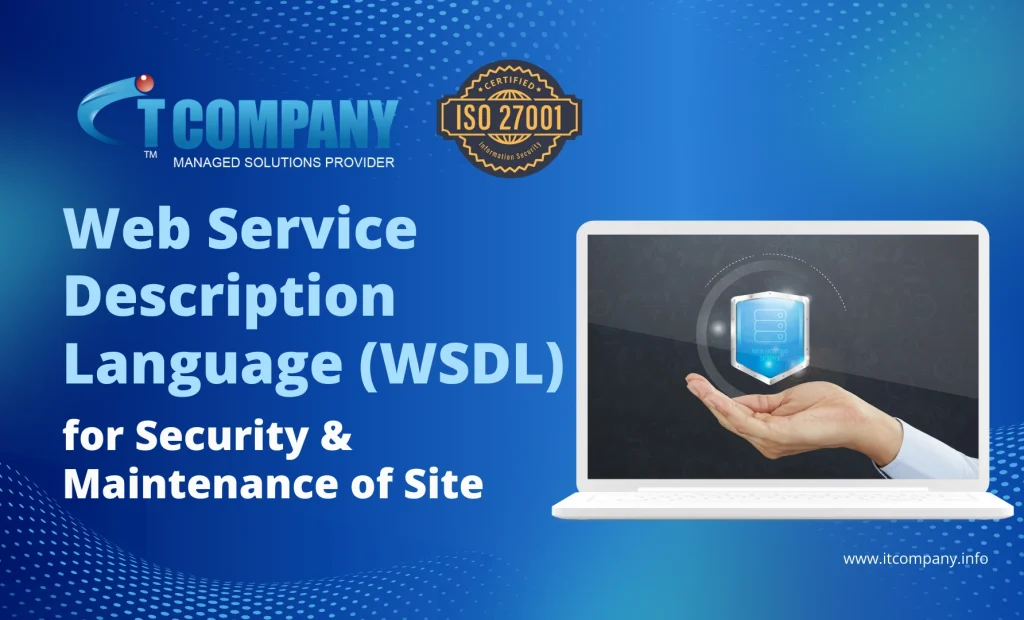
In the realm of web services, the Web Service Description Language (WSDL) comes into play alongside key techniques like SOAP and REST. For any IT Company, WSDL plays a very important role as it describes the functions of a web service and enable other network participants to leverage these services effectively.
This article helps you explore how WSDL works, and how it is important for web services. We will also explore its relation to website design and maintenance of site.
Table of Contents
ToggleWhat is WSDL?
WSDL stands for Web Service Description language, a meta language that describes web services. WSDL allows servers to provide functionalities to clients over the internet. This feature enables the communication gap between system and applications which is essential for IT Companies in designing and maintaining a website.
A WSDL file typically hosted on server, guides clients on available operations and interaction in serving. These files in XML and XML Schema ensures consistency, and reliability.
How WSDL Works
WSDL operates by providing a structured document that outlines the capabilities of a web service. When a client accesses the WSDL file, it receives a clear understanding of the service’s functionality and how to engage with it.
It provides a structured document that outlines the capabilities of a web service. When a client accesses that WSDL file, it receives a clear understanding of a server’s functionality and how to engage them.
Components of WSDL
| Element | Description |
| Types | Defines the data types used by the web service. |
| Messages | Describes the data to be transmitted between the client and server. |
| Interface (Port Type) | Outlines the abstract operations that define the communication protocol between the client and server. |
| Binding | Specifies the transport protocol (e.g., HTTP, SMTP) that the service uses. |
| Endpoint (Service) | Provides the communication interface, typically in the form of a URI. |
| Service | Lists the access points of the web service, detailing how clients can connect to it. |
By detailing these elements, a WSDL file enables clients to gather all the necessary information to utilize the web service effectively. This capability is what makes web services platform-independent, as various systems can communicate using the shared language defined by the WSDL file.
Common Use Cases for WSDL
WSDL is useful in following scenarios.
- Enterprise Application Integration: Organizations often use WSDL to facilitate communication between various enterprise applications, ensuring seamless data exchange.
- Third-Party Service Integration: Developers can utilize WSDL to integrate external services into their applications, leveraging pre-built functionalities.
- API Management: WSDL helps in managing APIs by providing clear documentation and standardizing interactions between clients and services.
Challenges and Limitations of WSDL
WSDL has its own limitations that affect its performance and advantages side. Few are here.
- Complexity and Verbosity: WSDL documents can become lengthy and complex, making them difficult to read and understand. This can pose challenges for IT companies in website design and maintenance, as intricate WSDL files may hinder efficient integration and troubleshooting.
- Limitations in RESTful Services: SOAP services use WSDL and it does not naturally align with RESTful services principles. Which leads to confusion for developers. And web developers are not expert in this domain.
- Performance Considerations: The size and complexity of WSDL files can impact performance, especially in scenarios involving multiple services. This is particularly relevant in website maintenance, where slow response times can affect user experience and site functionality.
Best Practices for Using WSDL
To make the most of WSDL, consider the following best practices:
- Design Effective WSDL Documents: Keep WSDL files concise and clear to enhance usability, making it easier for developers involved in website design and maintenance to integrate and utilize web services.
- Use Tools for Validation: Utilize available tools to validate WSDL documents, ensuring they conform to standards. This helps maintain consistency and reliability, which is crucial for effective website functionality.
- Keep Documentation Updated: Regularly update WSDL files to reflect any changes in the web service’s functionality. Keeping documentation current is vital for smooth website maintenance and for facilitating seamless communication between systems.
WSDL and Website Security & Maintenance
Ensuring Accurate Communication
- WSDL Validation: Validating WSDL documents ensures that the defined web service operations, message formats, and protocols are correctly specified. Accurate definitions help prevent miscommunication between clients and services, reducing vulnerabilities caused by unexpected inputs or outputs.
- Security Implications: If a WSDL document is incorrect or poorly defined, it can lead to security loopholes where attackers might exploit unexpected behavior in the service.
Input Validation
- Role of WSDL: WSDL specifies the data types and structures expected by the web service. Proper validation of WSDL helps ensure that the service only accepts well-defined inputs.
- Mitigating Attacks: By enforcing strict input types, developers can mitigate risks such as XML injection or buffer overflow attacks, enhancing overall website security.
Consistent Updates and Security Practices
- Keeping WSDL Updated: Regularly updating WSDL files to reflect changes in web service functionality or security protocols is essential. This practice ensures that clients have the latest information to interact securely with the service.
- Proactive Security Measures: Updating WSDL alongside security enhancements helps ensure that clients are aware of any new security measures, such as authentication or encryption methods.

Compliance with Standards
- Standards and Security: Validating WSDL against industry standards ensures that the web service adheres to best practices, which often include security considerations.
- Regulatory Compliance: Data protection and privacy is directly link with standard procedures and practices which helps organizations to regulate in a safe and secure way.
Interoperability and Security Protocols
- Service Integration: WSDL facilitates interoperability between different systems. WSDL validation ensures correctly defined security protocols like (WS-Security).
- Secure Communication: We secure data transit through HTTPS, and WSDL is an important protocol to secure communication.
Conclusion
WSDL is a vital component of web services, providing a standardized way to describe and interact with service functionalities. By understanding its structure, components, and applications, developers can harness the power of web services more effectively, facilitating seamless communication across diverse platforms.